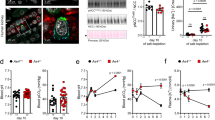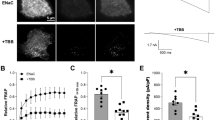Abstract
Autosomal dominant distal renal tubular acidosis (ddRTA) is caused by mutations in SLC4A1, which encodes the polytopic chloride–bicarbonate exchanger AE1 that is normally expressed at the basolateral surface of α-intercalated cells in the distal nephron. Here we report that, in contrast with many disorders in which mutant membrane proteins are retained intracellularly and degraded, ddRTA can result from aberrant targeting of AE1 to the apical surface.
This is a preview of subscription content, access via your institution
Access options
Subscribe to this journal
Receive 12 print issues and online access
$209.00 per year
only $17.42 per issue
Buy this article
- Purchase on Springer Link
- Instant access to full article PDF
Prices may be subject to local taxes which are calculated during checkout


Similar content being viewed by others
References
Karet, F.E. J. Am. Soc. Nephrol. 13, 2178–2184 (2002).
Karet, F.E. et al. Proc. Natl. Acad. Sci. USA 95, 6337–6342 (1998).
Bruce, L.J. et al. J. Clin. Invest. 100, 1693–1707 (1997).
Jarolim, P et al. J. Biol. Chem. 273, 6380–6388 (1998).
Quilty, J.A., Li, J. & Reithmeier, R.A. Am. J. Physiol. Renal Physiol. 282, F810–F820 (2002).
Toye, A.M., Bruce, L.J., Unwin, R.J., Wrong, O. & Tanner, M.J. Blood 99, 342–347 (2002).
Bonifacino, J.S. & Dell'Angelica, E.C. J. Cell Biol. 145, 923–926 (1999).
Mostov, K.E., Verges, M. & Altschuler, Y. Curr. Opin. Cell Biol. 12, 483–490 (2000).
Obrador, G. et al. J. Am. Soc. Nephrol. 9, 746–754 (1998).
Low, S.H. et al. Mol. Biol. Cell 11, 3045–3060 (2000).
Ihrke, G., Bruns, J.R., Luzio, J.P. & Weisz, O.A. EMBO J. 20, 6256–6264 (2001).
Ohno, H. et al. Science 269, 1872–1875 (1995).
Ohno, H. et al. FEBS Lett. 449, 215–220 (1999).
Fölsch, H., Ohno, H., Bonifacino, J.S. & Mellman, I. Cell 99, 189–198 (1999).
Koivisto, U.M., Hubbard, A.L. & Mellman, I. Cell 105, 575–585 (2001).
Acknowledgements
We thank N. Rungroj and Y. Su for technical assistance, P. Luzio, M. Robinson and R. Sandford for invaluable discussion and J. Schwartz for IMCD cells. This work was supported by the Wellcome Trust, the UK National Kidney Research Fund, Addenbrooke's Charities and Children's Kidney Care Fund and the Renal Care and Research Association. M.A.J.D. received a Sackler Fellowship.
Author information
Authors and Affiliations
Corresponding author
Ethics declarations
Competing interests
The authors declare no competing financial interests.
Rights and permissions
About this article
Cite this article
Devonald, M., Smith, A., Poon, J. et al. Non-polarized targeting of AE1 causes autosomal dominant distal renal tubular acidosis. Nat Genet 33, 125–127 (2003). https://doi.org/10.1038/ng1082
Received:
Accepted:
Published:
Issue Date:
DOI: https://doi.org/10.1038/ng1082
This article is cited by
-
The pathophysiology of distal renal tubular acidosis
Nature Reviews Nephrology (2023)
-
Pathophysiology, diagnosis and treatment of inherited distal renal tubular acidosis
Journal of Nephrology (2018)
-
PDLIM5 links kidney anion exchanger 1 (kAE1) to ILK and is required for membrane targeting of kAE1
Scientific Reports (2017)
-
Renal peroxiredoxin 6 interacts with anion exchanger 1 and plays a novel role in pH homeostasis
Kidney International (2016)
-
Proximal tubule specific knockout of the Na+/H+ exchanger NHE3: effects on bicarbonate absorption and ammonium excretion
Journal of Molecular Medicine (2013)



